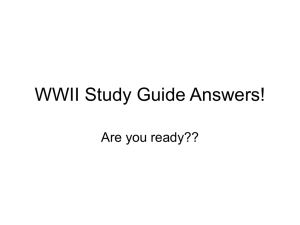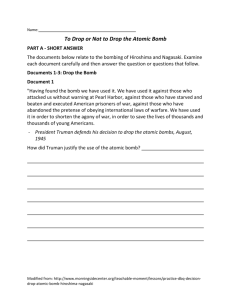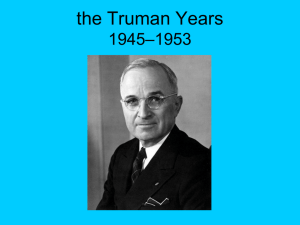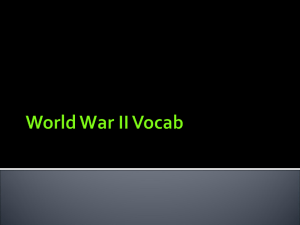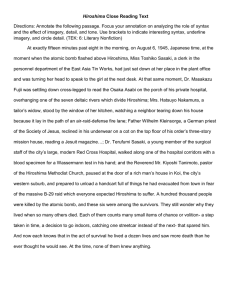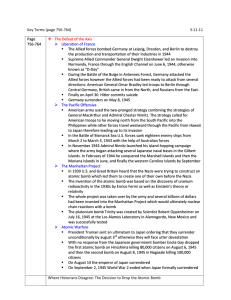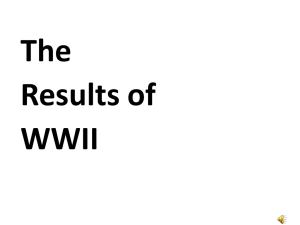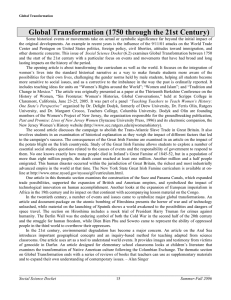Causes of World War II
advertisement
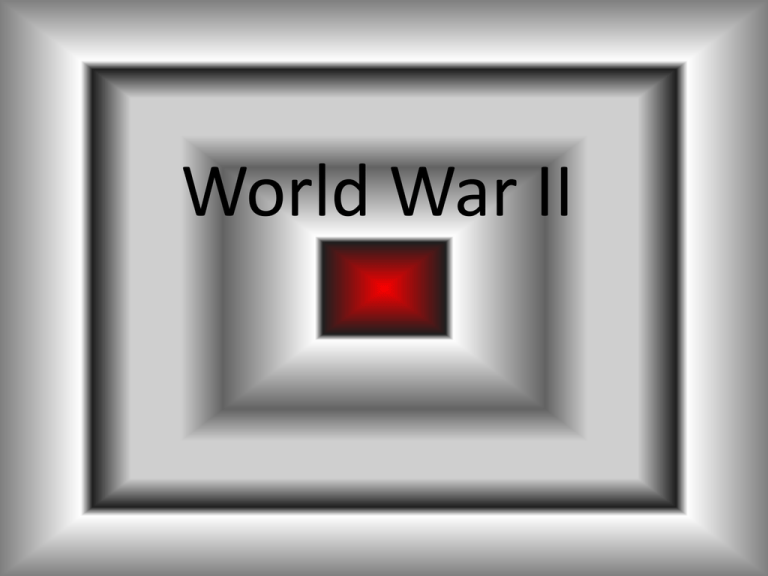
World War II Causes of World War II -Resentment at the harsh peace of World War • Political instability and One fuelled the rise of economic devastation in Adolf Hitler. Anxious to Europe resulting from avoid war, Britain and WWI France chose to – Worldwide depression appease German – High war debt owed by territorial demands Germany before finally 'drawing a – High Inflation line in the sand' over – Massive unemployment Poland. • Fascism –Fascism is a political philosophy in which total power is given to a dictator and individual freedoms are denied • Dictator –A person who rules with total authority, often in a cruel manner. Rise of Fascism • Fascist dictators included: –Adolph Hitler (Germany) Benito Mussolini (Italy) Hideki Tojo (Japan) ●These dictators led the countries that became known as the Axis Powers Start of World War II • Germany and the Soviet Union signed a nonaggression pact – agreeing to never attack each other. • Germany invaded Poland September 1, 1939. This marks the beginning of WWII. • The Soviet Union also invaded Poland and the Baltic nations. German Advances • Germany invaded France and captured Paris. • Germany Bombed London in the Battle of Britain. • The British were able to turn away the Germans due to the invention of RADAR Gradual change in American policy from neutrality to direct involvement • 1. Isolationism – The U.S. refuses to join the League of Nations after WWI – The U.S. stays isolated during the Great Depression 2. Lend-Lease Act • The United States gave Britain war supplies and old naval warships in return for military bases in Bermuda and the Caribbean War in the Pacific • Rising tension developed between the U.S. and Japan because of Japanese aggression in East Asia. Pearl Harbor • On Dec. 7, 1941, Japan attacked the U.S. at Pearl Harbor without warning. 3. Direct Involvement in the war • Japan declared war on the U.S., so the U.S. declared war on Japan and Germany. The Allies • Democratic nations (The United States, Great Britain, Canada) were known as the Allies. • The Soviet Union joined the Allies after being invaded by Germany • Allied leaders included: – Franklin D. Roosevelt and later Harry S. Truman – U.S. – Winston Churchill – Great Britain – Joseph Stalin – Soviet Union Turning point in the Pacific • The Battle of Midway, fought over and near the tiny U.S. mid-Pacific base at Midway atoll, represents the strategic high water mark of Japan's Pacific Ocean war. • Prior to this action, Japan possessed general naval superiority over the United States and could usually choose where and when to attack. After Midway, the two opposing fleets were essentially equals, and the United States soon took the offensive. Turning point in Europe • In September 1943 a German army entered the city of Stalingrad and began fighting for the city. The main battle, The Battle of Stalingrad was a fierce struggle. Soldiers fought for each city block. In November 1942, more Soviet troops arrived and surrounded the German army. In late January 1943, with supplies running low, the remaining German troops in Stalingrad surrendered to the Soviet Union. D – Day • American and Allied troops landed in Normandy, France, on D-Day to begin the liberation of Western Europe. End of War in Europe • Liberation of France (DDay) • Liberation of Western Europe by the U.S., French, and British after D-Day • Death of FDR April 12, 1945 • Liberation of Eastern Europe by the Soviets • Suicide of Adolph Hitler, April 30, 1945 End of War in The Pacific • Truman takes over as president. • Truman decides to drop the Atomic bomb on Japan. – Atomic Bomb will save American soldiers lives, but will cost many innocent women and children theirs. Hiroshima • As many know, the atomic bomb has been used only twice in warfare. The first was at Hiroshima. A uranium bomb nicknamed "Little Boy" (despite weighing in at over four and a half tons) was dropped on Hiroshima August 6, 1945. • The Aioi Bridge, one of 81 bridges connecting the sevenbranched delta of the Ota River, was the target; ground zero was set at 1,980 feet. At 0815 hours, the bomb was dropped from the Enola Gay. It missed by only 800 feet. At 0816 hours, in an instant, 66,000 people were killed and 69,000 injured by a 10kiloton atomic explosion. • The area of total vaporization from the atomic bomb blast measured one half mile in diameter; total destruction one mile in diameter; severe blast damage as much as two miles in diameter. Within a diameter of two and a half miles, everything flammable burned. The remaining area of the blast zone was riddled with serious blazes that stretched out to the final edge at a little over three miles in diameter. Little Boy and Fat Man • After the Hiroshima bombing, President Truman announced, "If they do not now accept our terms, they may expect a rain of ruin from the air the likes of which has never been seen on this earth." Japan still refused to surrender. Nagasaki • On August 9, 1945, Nagasaki fell to the same treatment. This time a Plutonium bomb nicknamed "Fat Man" was dropped on the city. Though "Fat Man" missed its target by over a mile and a half, it still leveled nearly half the city. In a split second, Nagasaki's population dropped from 422,000 to 383,000. Over 25,000 people were injured. • Japan offered to surrender on August 10, 1945, ending WWII. • NOTE: Physicists who have studied these two atomic explosions estimate that the bombs utilized only 1/10th of 1 percent of their respective explosive capabilities. Effects of Atomic Bombs RayBurns WWII on the Home Front • American involvement in WWII brought an end to the Great Depression. Factories and workers were needed to produce goods to win the war. -Thousands of American women took jobs in defense plants during the war (e.g., Rosie the Riveter). WWII Propaganda • What does this poster mean? • It is asking Americans to save gas by riding together. • Those that ride alone are helping the Germans win the war, by wasting fuel. • Why did this woman turn her bumpers into the scrap heap? • So they could be turned into weapons for the war. Rationing • Americans at home supported the war by conserving and rationing resources. http://www.u-shistory.com/pages/h1674.html Racial Barriers • The need for workers temporarily broke down some racial barriers (e.g., hiring in defense plants) although discrimination against African Americans continued. • Truman desegregated the Armed Forces Internment Camps • While many Japanese Americans served in the armed forces, others were treated with distrust and prejudice, and many were forced into internment camps.

